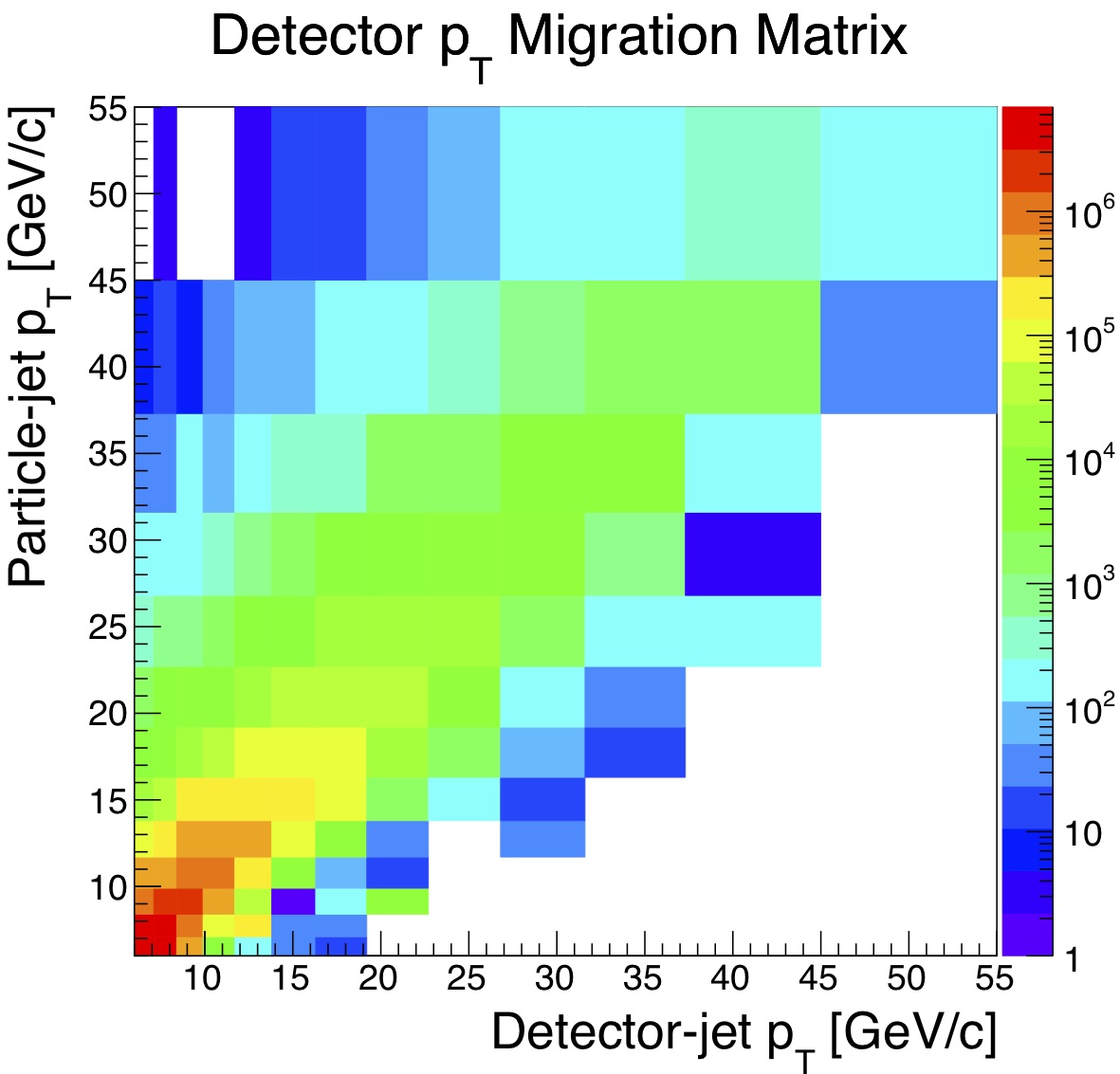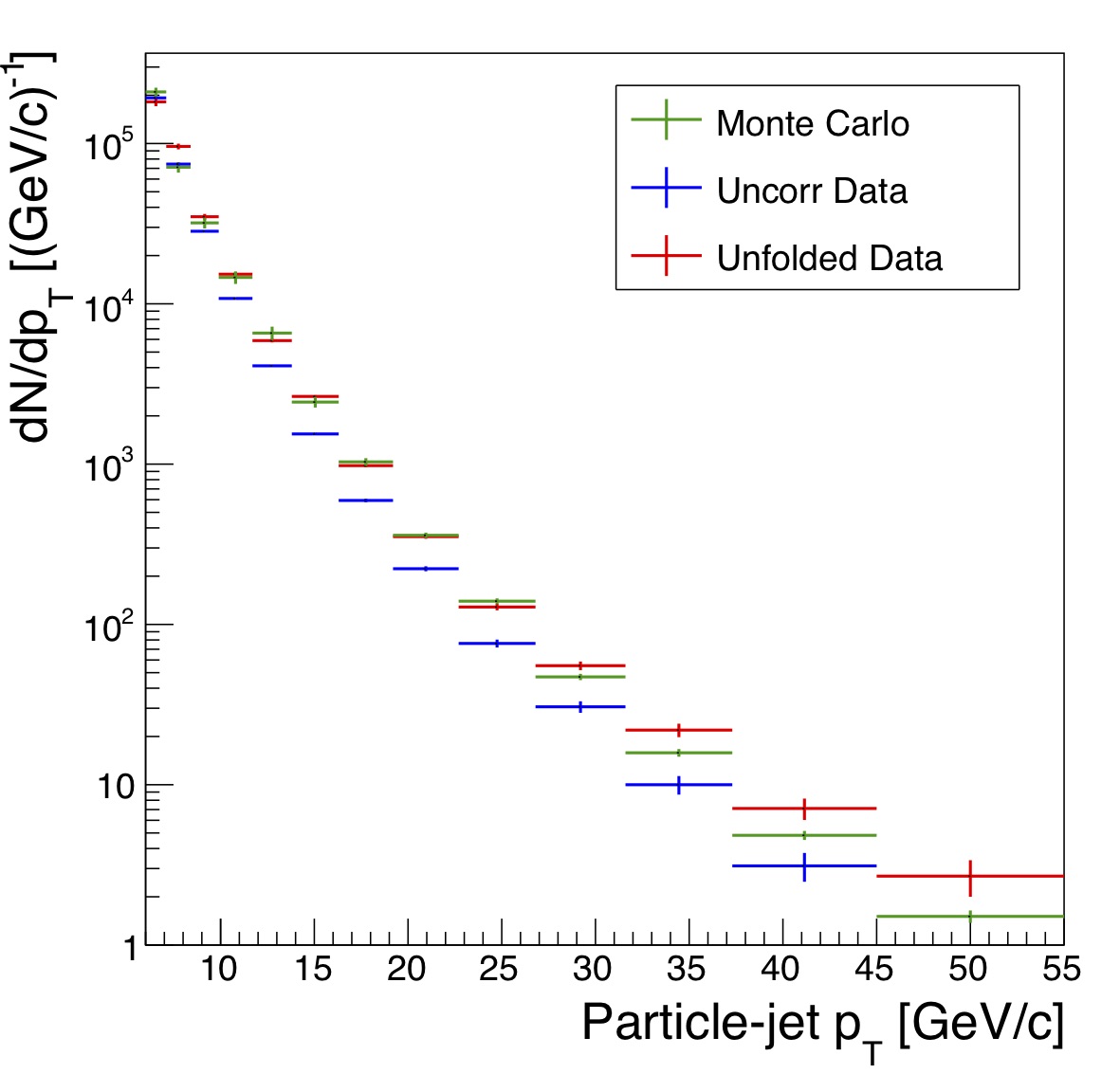- drach09's home page
- Posts
- 2022
- 2020
- June (1)
- 2019
- 2018
- 2017
- 2016
- 2015
- 2014
- December (13)
- November (2)
- October (5)
- September (2)
- August (8)
- July (9)
- June (7)
- May (5)
- April (4)
- March (4)
- February (1)
- January (2)
- 2013
- December (2)
- November (8)
- October (5)
- September (12)
- August (5)
- July (2)
- June (3)
- May (4)
- April (8)
- March (10)
- February (9)
- January (11)
- 2012
- 2011
- October (1)
- My blog
- Post new blog entry
- All blogs
500 GeV Fragmentation Function Analysis Plan
The Plan
Step 1: Unmatched Corrections
- Correct full detector-jet spectrum for underlying event contributions
- Correct pion-in-jet spectrum for underlying event contributions
- Correct full detector-jet spectrum to remove detector jets that do not match to a particle jet
- Correct pion-in-jet spectrum to remove events that do not match to a pion-in-jet at the particle-jet level
Step 2: Unfolding
- Unfold full jet pT spectrum, regardless of pions
- Use RooUnfold Bayesian for 1-D unfolding
- Unfold pion-in-jet spectrum, e.g. in terms of jet pT, pion z, pion jT
- Use RooUnfold Bayesian for 2-D or 3-D unfolding, TBD
Step 3: Efficiency Correction
- Correct full jet reconstruction efficiency using embedded Monte Carlo
- Correct full pion-in-jet reconstruction efficiency using embedded Monte Carlo
First Look at Unfolding
For this first look, I do the following analysis:
- Loop over events
- Select events with M.C. |zvtx| < 30 cm (not sure about this one)
- Loop over particle jets
- Select jets with |η| < 0.5
- Histogram the particle-jet pT spectrum, i.e. spectrum of "all" particle jets
- Loop over detector jets
- Select jets from events with the "best" vertex, positive-rank vertex, and |reco. zvtx| < 30 cm
- Select jets with no tracks with pT > 30 GeV/c, RT < 0.94, ∑pT,ch > 0.5 GeV/c, |ηdet-0.1| < 0.8, and |η| < 0.5
- Select events with |M.C. zvtx-reco. zvtx| < 2 cm
- Select jets with pT > 5 GeV/c
- Calculate angular separation, ΔR = (Δη2+Δφ2)1/2
- Select events with ΔRmin < 0.5 and call the associated detector jet its "match"
- Histogram the "matched" particle-jet pT spectrum
- Histogram the "matched" particle-jet pT vs. associated detector-jet pT spectrum
- Loop over particles within the particle jet
- Select pions
- Histogram the particle-jet pT vs. true pion z vs. true pion jT spectrum
- Loop over detector jets
- Select jets from events with the "best" vertex, positive-rank vertex, and |reco. zvtx| < 30 cm
- Select jets with no tracks with pT > 30 GeV/c, RT < 0.94, ∑pT,ch > 0.5 GeV/c, |ηdet-0.1| < 0.8, and |η| < 0.5
- Select events with |M.C. zvtx-reco. zvtx| < 2 cm
- Select jets with pT > 5 GeV/c
- Select events with ΔR = (Δη2+Δφ2)1/2 < 0.5
- Loop over tracks within the detector jet
- Select tracks with z > 0.1
- Select tracks with Nhits,dE/dx > 5
- Select tracks within the "pion" nσ(π) range, as defined by the 2011 Collins paper
- Calculate angular separation, ΔR = (Δη2+Δφ2)1/2
- Select events with particle ΔRmin < 0.5 and call the associated track its "match"
- Histogram the "matched" particle-jet pT vs. true pion z vs. true pion jT spectrum
- Histogram the associated detector-jet pT vs. reco pion z vs. reco pion jT spectrum for the matched "truth" bins
- Loop over particle jets
- Loop over detector jets
- Select jets from events with the "best" vertex, positive-rank vertex, and |reco. zvtx| < 30 cm
- Select jets with no tracks with pT > 30 GeV/c, RT < 0.94, ∑pT,ch > 0.5 GeV/c, |ηdet-0.1| < 0.8, and |η| < 0.5
- Select events with |M.C. zvtx-reco. zvtx| < 2 cm
- Select jets with pT > 5 GeV/c
- Histogram the detector-jet pT spectrum, i.e. spectrum of "all" detector jets passing the cuts
- Loop over all particle jets
- Select particle-jets with |η| < 0.5
- Calculate angular separation, ΔR = (Δη2+Δφ2)1/2
- Select events with ΔRmin < 0.5 and call the associated particle jet its "match"
- Histogram the "matched" detector-jet pT spectrum
- Histogram the "matched" detector-jet pT vs. associated particle-jet pT spectrum
- Loop over tracks within the detector jet
- Select tracks with z > 0.1
- Select tracks with Nhits,dE/dx > 5
- Select tracks within the "pion" nσ(π) range, as defined by the 2011 Collins paper
- Histogram the detector-jet pT vs. track z vs. track jT spectrum
- Loop over particle jets
- Select events with ΔR = (Δη2+Δφ2)1/2 < 0.5
- Loop over particles within the particle jet
- Calculate angular separation, ΔR = (Δη2+Δφ2)1/2
- Select events with particle ΔRmin < 0.5 and call the associated particle its "match"
- Histogram the "matched" detector-jet pT vs. track z vs. track jT spectrum
- Histogram the associated particle-jet pT vs. particle z vs. particle jT spectrum for the matched "reco" bins
- Select events with M.C. |zvtx| < 30 cm (not sure about this one)
Figure 1: Jet Efficiency Corrections

Figure 1 shows (left) the ratio of "matched" particle jets to "all" particle jets vs. particle-jet pT and (right) the ratio of "matched" detector jets to "all" detector jets vs. detector-jet pT. Jets were subject to the selection criteria described above.
Figure 2: Migration Matrix

Figure 2 shows the migration matrix based upon matched detector jets, as described above.
Figure 3: Unfolded Jet Spectra

Figure 3 shows the jet pT spectra for particle jets with |η| < 0.5 (green), uncorrected VPDMB data (blue) with selection criteria as described above, and unfolded VPDMB data (red). The unfolding was done with the Bayesian algorithm in RooUnfold with four iterations, passing it the migration matrix from Fig. 2 and entering "0" for both the "measured" and "truth" fields in RooUnfoldResponse. This is because I wanted to handle the inefficiency and "fakes" corrections by hand. All spectra and uncertainties were scaled by 1/bin width. The particle-jet spectrum is normalized to the data yield within the range 6-55 GeV/c. Note: this means that for this first pass, I essentially have no buffer bins for the unfolding. Before unfolding, data were scaled by the matched-detector-jet fractions from Fig. 1 (right) to correct the yield for unmatched detector jets. After unfolding, the data were scaled by the inverse of the matched-particle-jet fractions from Fig. 1 (left) to correct the yield for unmatched particle jets.
- drach09's blog
- Login or register to post comments
